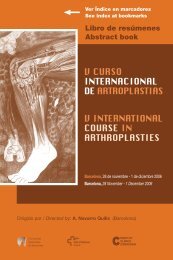Notas / Notes - Active Congress.......
Notas / Notes - Active Congress.......
Notas / Notes - Active Congress.......
You also want an ePaper? Increase the reach of your titles
YUMPU automatically turns print PDFs into web optimized ePapers that Google loves.
JUEVES / THURSDAY<br />
120<br />
11.15 - 12.00 h<br />
CADERA / HIP<br />
Infecciones / Infections<br />
Moderador: Xavier Flores<br />
THE DIAGNOSIS AND MANAGEMENT OF<br />
PERI-PROSTHETIC INFECTIONS<br />
P McLardy-Smith, B Atkins, H Pandit, T Berendt, N<br />
Athanasou & the Oxford Hip and Knee Group (Richie<br />
Gill, David Beard, Vicky Flanagan, Chris Dodd, Max<br />
Gibbons, Roger Gundle, David Murray, Andrew Price,<br />
Duncan Whitwell)<br />
California (USA)<br />
Total hip replacement is probably the most successful operation<br />
ever devised and other joints, particularly the knee<br />
are now being successfully replaced. However peri-prosthetic<br />
infection remains a potentially catastrophic complication.<br />
Infection rates are reported at between 1- 2% and the risk<br />
of a peri-prosthetic infection runs over the entire life time of<br />
the joint. Peri-prosthetic infections can usefully categorised<br />
as early acute or chronic and late acute or chronic. The<br />
diagnosis of chronic infections, particularly late ones, may<br />
be difficult to achieve pre-operatively. Imaging techniques<br />
and serological testing can be useful but are not as yet<br />
reliable or specific. Aspiration or closed biopsy are similarly<br />
unreliable. Any joint revised for any reason may have an<br />
underlying infection. In a prospective study of 334 consecutive<br />
hip and knee revisions we sent multiple samples from each<br />
case for bacteriological and histological analysis. We used<br />
the histological appearance as the criterion for defining<br />
infection. By this definition 15% of infected cases were culture<br />
negative and one positive culture specimen has no predictive<br />
value for under lying infection. Two or more positive cultures<br />
out of 5 or 6 samples as a useful predictive value.<br />
In acute infections, if the components are soundly fixed,<br />
salvage should be attempted with adequate debridement<br />
sampling and lavage of the joint. Arthroscopic washout in<br />
Staphylococcal knee infections has a very poor outcome.<br />
We would then recommend long term antibiotic therapy.<br />
Salvage maybe possible in chronic infections, but usually<br />
the components are loose within the bone and a full revision<br />
will be required. Frozen section histological analysis of the<br />
tissue at the time of surgery can differentiate septic from<br />
aseptic loosening and maybe relied upon to choose between<br />
a one or a two stage revision.<br />
INFECTED TOTAL HIP ARTHROPLASTY.<br />
ONE STAGE REVISION<br />
B. M. Wroblewski, H. Nagai, P. D. Siney, P. A. Fleming<br />
The John Charnley Research Institute, Wrightington Hospital,<br />
Hall Lane, Appley Bridge Near Wigan (Great Britain)<br />
One of the most serious complications of THA is deep infection.<br />
Charnley realised the problem. This led to the development<br />
of clean air enclosure, total body exhaust suits and the introduction<br />
of the instrument tray system. Subsequently antibiotics<br />
were used both systematically and also as an addition to the<br />
acrylic cement. Occasional deep infection requires further intervention,<br />
either by removing the implant, or performing one<br />
or two stage revision.<br />
It has been the senior author’s practice to undertake one-stage<br />
revision provided the bone stock was of sufficiently good quality<br />
to ensure reasonable quality of component fixation. The technique<br />
is based on the accepted principle of infection management:<br />
Removal of all foreign body material and infected tissues,<br />
application of local antiseptics/antibiotics, closure of cavities,<br />
ensuring stability, drainage, rest, continuation of antibiotics.<br />
Between January 1974 and December 2001, 185 one-stage<br />
revisions were carried out by the senior author: 162 had a<br />
minimum follow-up of 5 years with a mean of 12.3 years (5.1<br />
– 27.6 years). 138 cases (85.2%) were free from infection.<br />
Presence of a sinus at revision did not affect the outcome<br />
adversely – on the contrary - 90.4% were infection free as<br />
compared with 82.7% of those without a sinus.<br />
THE MARSA GHOST<br />
Thorsten Gehrke<br />
Endo-Klinik. Hamburg (Alemania)





